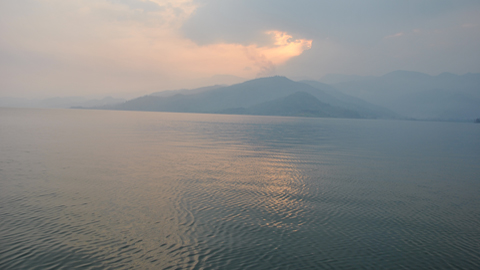African lake provides new clues about ancient marine life

01/02/2017
Members of the University of British Columbia (UBC) and researcher Marc Llirós from the UAB Department of Genetics and Microbiology travelled to Lake Kivu in the Democratic Republic of Congo, because of its similar chemistry to the oceans of the Proterozoic eon, some 2.3 to 0.5 billion years ago.
The deep waters of part of the lake have no oxygen and are one of the few places on Earth where dissolved iron is present at high concentrations.
“This is the first time that we have observed microbes recycling nitrogen by reacting it with iron in such a body of water,” said Céline Michiels, lead author of the study and PhD student at UBC. “While these reactions have been observed in the lab, their activity in Lake Kivu gives us confidence that they can play an important role in natural ecosystems and allows us to build math models that can describe these reactions in oceans of the past.”
Michiels and her colleagues found that when microorganisms from Lake Kivu react iron with nitrogen in the form of nitrate, some of this nitrogen is converted to gas, which is lost to the atmosphere, but the rest of the nitrogen is recycled from nitrate to ammonium, which remains dissolved and available for diverse microorganisms to use as a nutrient.
The research, published in Nature Geoscience, used math models informed by data collected from lake Kivu to learn more about how this recycling could have affected life in the oceans during the Proterozoic eon. They learned that biological activity was not limited by the availability of nitrogen, as previously thought, but rather was likely limited by another key nutrient, phosphorous. Nutrient availability would have played an important role in shaping the nature and activity of life in the oceans at this time, thus setting the stage for the evolution of multicellular life and Eukaryotes.
“Lake Kivu, with its physical chemistry, its organisms and their metabolism are a window to the Earth's past, an exceptional living fossil providing evidences of the Earth's history and allowing the design of mathematical models to build the chemistry and the biology from nearly two billions of years”, says Marc Llirós.
“With these models and fossil registries, we are learning more and more about how evolving life in the ancient oceans shaped Earth’s surface chemistry over long stretches of early history”, concluded Sean Crowe, senior author of the study.
This research was part of the East African Great Lakes Ecosystem Sensitivity to changes project, a broader initiative to study microbial ecology in African Great Lakes, led by Belgium researchers François Darchambeau, of the Université de Liège, and Jean-Pierre Descy, of the Université of Namur.
Article: Céline C. Michiels, François Darchambeau, Fleur A. E. Roland, Cédric Morana, Marc Llirós, Tamara García-Armisen, Bo Thamdrup, Alberto V. Borges, Donald E. Canfield, Pierre Servais, Jean-Pierre Descy & Sean A. Crowe. Iron-dependent nitrogen cycling in a ferruginous lake and the nutrient status of Proterozoic oceans. Nature Geoscience (2017) doi:10.1038/ngeo2886